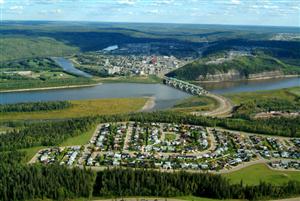Fort McMurray
The Fort McMurray area was originally dominated by Cree from 1700 to 1787 until the Chipewyan people moved down from the north (FMHS website 2008). In 1870 both Chipewyan and Cree First Nation People traded at the Hudson’s Bay Company trading post called Fort McMurray built by Henry John Moberly at the confluence of the Athabasca and Clearwater Rivers (FMHS website 2008). The trading post was called Fort McMurray after William McMurray who worked for the Hudson’s Bay Company as chief factor of the Athabasca region (FMHS website 2008).
Up until 1921, when the railroad reached Waterways, the main mode of transportation was by the river. In 1889, the Hudson’s Bay Company launched a sternwheeler steamer called the SS Athabasca to carry freight and passengers between Fort McMurray and Fort Chipewyan. Passengers could then travel down the Slave River to the McKenzie River and further to the Arctic Ocean. York boats also traveled up stream on the Athabasca River opening up a direct route through to Edmonton where it would meet the railroad (FMHS website 2008).
The Fort McMurray area is made up of mixed forests, undulating hills, rivers, creeks, and muskeg bogs. The highlands are covered with Aspen, Jack Pine and White Spruce and, willow species, Black Spruce and Larch Tamarack grow in the wetlands. The Clearwater, Horse, and Hanging Stone Rivers all join the Athabasca River in Fort McMurray to flow north to the Arctic Ocean.
The population of Fort McMurray has grown steadily over the last century. In 1901 the population of Fort McMurray was 28 where as today 65,400 people live in Fort McMurray. The total population for the Regional Municipality of Wood Buffalo is 89,000 (RMWB website 2007).










